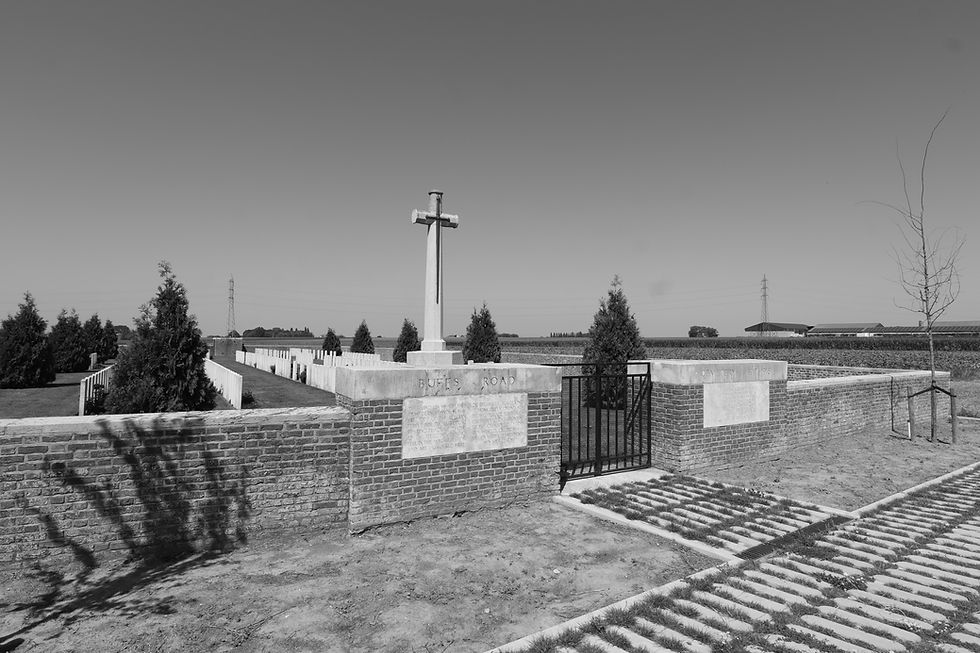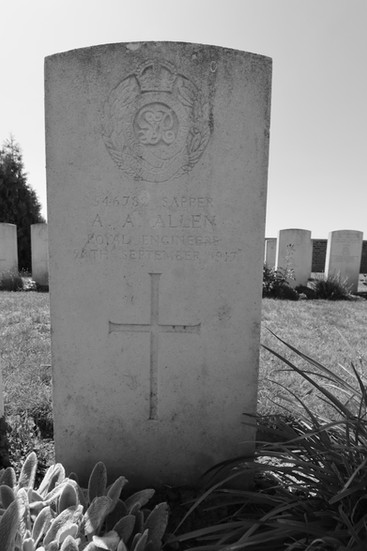Buffs Road Cemetery
- Admin
- Oct 30
- 8 min read
Updated: Oct 31

Buffs Road was the name given to a small lane, which ran between Boundary Road and Admiral's Road, just to the north of the hamlet of Wieltje. This is a battlefield burial ground and was in No Man’s Land before the Third Battle of Ypres began on 31 July 1917. The cemetery was made and used by fighting units, in particular by the 12th, 13th and 14th Royal Sussex Regiment, and the Royal Field Artillery and Royal Garrison Artillery between July 1917 and March 1918. After the Armistice graves were brought into the cemetery from the battlefield and Row EE which runs the length of the cemetery contains 66 burials of which only seven are identified, four of these are Australians killed in the fighting in late 1917, and part of Row B. One British officer, who fell in 1915, was brought in from Brielen Churchyard.
Second Battle of Ypres
Mousetrap Farm, it was originally named on the trench maps as Shell Trap Farm however, this was deemed not good for morale, it can be seen on the ridge to the west of the cemetery. It was in this area on 25 April 1915 that the 10th Brigade, including the 1/7th Battalion Argyll & Sutherland Highlanders, Falkirk’s Territorial Battalion, made their disastrous counter-attack against the German line. The Lahore Division, Sirhind Brigade, made their ill-fated failed attack at Hill Top Ridge on 27 April, Major Bernard Maynard Brodhurst, 1st Battalion, 4th Gurkha Rifles was killed in that attack and is buried at La Brique Cemetery No.2. On the 2 May 1915, the Germans, using incendiary and gas shells which created a green yellowish fog, attacked the British line here against the Essex Regiment. Part of the line was evacuated but a number of the Essex men held their positions and were supported by men from ‘C’ Company, 2nd Battalion Monmouthshire Regiment, in holding the line. Lieutenant Alexander Evan Fraser was killed in this action and he is buried at La Brique Cemetery No.2. The Lancashire Fusiliers were also in the line during the attack, they began the day with thirty-three officers and 1,070 other ranks, and when relieved had eight officers and eighty other ranks. Private John ‘Jack’ Lyons won his Victoria Cross in the line during the attack when he manned his machine gun without a gas mask, gas masks where not standard issue at this time, he halted the German attack, He was found barely alive and died later from the effects of gas and is buried in Grotebeek Cemetery at Ouderdom.

Royal Engineers
There are thirteen men from the Royal Engineers buried here. The details of eight men are shown. All from various Field Companies. A typical Field Company consisted of 217 men with specialized trades like carpenters, blacksmiths, and masons. The company was organized into ‘Mounted’ and ‘Dismounted’ sections, with the former including officers and NCOs with riding horses and the latter comprising all the tradesmen and general labourers. Two men from the 247th Field Company, Royal Engineers, 63rd (Royal Naval) Division This company was raised from March 1915 for the Royal Naval Division. 207179 Sapper Walter Joseph Atkins, Killed in action 26 October 1917, age 22. Grave C.47. Youngest son of Albert E. and Ellen Atkins, 62 Pix Road, Letchworth, Herts. Native of Cold Blow, Walmer, Kent. 207752 Sapper Wilfrid Kingsbury, Killed in action 26 October 1917, age 23. Grave C.46. Youngest son, he had a brother Walter, of James and Ruth Kingsbury, 199 Woodbottom Terrace, Walsden, Todmorden. The 1911 Census lists him as employed as a plumber. From the 11 to 25 October the Company came under the orders of Commander Royal Engineers 9th (Scottish) Division who were located in the Poelcappelle sector. The Company was employed in the rear areas working on drainage work, making a corduroy road along the line of an existing road from Triangle Farm to Genoa Farm, laying a light railway track with a switch line from Hubner Farm to Quebec Farm. On the 26 October the Company came under the orders of the CRE 63rd (Royal Naval) Division with three Other Ranks attached to 188th Infantry Brigade, three to each Battalion, for demolition work for operations in front of Passchendaele, they were not called upon. The Company also extended the duckboard walkway from Alberta Farm to Burns Cottage and Mousetrap Track to beyond Adler Farm. The War Diary makes no mention of casualties however, working in the open and in daylight was a dangerous place to be.


Four men from the 474th (1st South Midland) Field Survey Company, Royal Engineers
This was Territorial unit and was responsible for mapping and surveying in support of military operations. The Company was formed as a part of the North Midland Divisional Engineers and joined the 48th (South Midland) Division. On the 28 September 1917 the Company was working on shelters behind California Trench, now behind British lines and located at Wieltje, with the War Diary recording that: ‘Major H Clissold killed by enemy shelling also Corpl W.J. Bubb, & Sappers Barber, Baker, Allen & 13 wounded.’ Major Henry Clissold DSO, age 46, is buried at Duhallow A.D.S. Cemetery. Grave I.C.49. He had been slightly wounded on 29 August 1917 and admitted to 61 Casualty Clearing Station however, he was well enough to return to the Company and to continue writing up the War Diary!
496843 Sapper James Thomas Baker, age 28. Grave E.37. Eldest son of Mr. and Mrs. James. A. Baker, of Southend-on-Sea; husband of Ada G. Baker, 39 Princes Avenue, Watford, Herts. They had a daughter who was two years old at the time of his death. His brother Albert was also killed in action. 494158 Sapper William John Barber, age 24. Grave E.34. Son of William and Eliza Barber, 28 Richmond Road, St. George's, Bristol. 546782 Sapper Alfred Arthur Allen, age 26. Grave E.36. He was the son of William and Loveday Fannie Allen. He was married to Mabel, they married on 15 January 1917, and they lived with his parents at Rose Cottage, Bugle, Cornwall. He was employed as a Wheelwright when he enlisted on 11 December 1915. 494182 Corporal William Joseph Bubb, age 26. Grave E.33. He was the eldest of three sons and a daughter of Thomas and Hannah Bubb, 65 Sussex Place, Ashley Road, Bristol. The 1911 census lists him as being employed as a plumber.

496161 Sapper Reginald John White, 475th (1st South Midland) Field Company, Royal Engineers, 48th Division. Killed in action 9 October 1917, age 25. Grave E.43. The eldest of two sons, with an older daughter and younger daughter of Frederick and Maria White, 4 St. Andrew's Terrace, Colyton, Devon. He was employed as a joiner. The War Diary records that the Company was working on the laying a line from Alberta to Triangle E, near Quebec Farm. They highlighted the difficulties in getting supplies and materials up to the dump at Triangle E, near Quebec Farm, owing to the numerous gun positions in the area and the consequent supply of ammunition. They were also hampered by constant shelling. With a short supply of transport the sappers and infantry assisting them had to carry the materials over a 4 mile march to the dump at Triangle E and because of the size of the parties they had to do this journey 3 times there and back covering an overall distance of 17 miles in the dark and across uneven and muddy ground, and in the rain. The War Diary records that: ‘In my opinion, the work was an example of guts & endurance on the part of all ranks & was the direct cause of saving many wounded who would otherwise have perished in the mud owing to the impossibility of their being brought back.’ On the 9 October they were trying to make headway in the daylight with the work but were constantly shelled and little progress was made.

93111 Serjeant James McAllister Distinguished Conduct Medal, 218th Field Company, Royal Engineers, 32nd Division. Killed in action 26 December 1917, age Grave B.1. Husband of Nellie McAllister, 21 Mid Street, Livingston, Mid Calder, Midlothian. They had two children. He won his DSO ‘For conspicuous gallantry and devotion to duty, always displaying great courage and coolness under fire, and energy and skill in the construction of strong points.’ During December 1917, the Company HQ was in the dugouts at California Trench with the Company working on laying a duckboard track from Kronprinz Switch to Winnipeg and in patrolling the Kronprinz track. They also carried out work at Vapour Farm and laying a duckboard track here. On the 17 December two sections of the Company were employed in patrolling and maintaining the decauville track and commencing a switch line from Winnipeg to the Battery of 161st Brigade, Royal Field Artillery, one section was working on the Corps Line, and another on the Divisional HQ. This work carried on until the Company was relieved on 30 December and went into billets at the Canal Bank.
Two men from the 503rd (Wessex) Field Company, Royal Engineers, 58th (2/1st London) Division. Was formed from the engineers of the 45th (2nd Wessex) Division in 1916 and was originally known as the 45th Divisional RE before being renumbered 503rd. The Company transferred to the 58th Division in February 1916, and it was deployed to the Western Front in early 1917. It was employed in working on maintaining fortifications, bridges, and other essential tasks. On the 20 September 1917, numbers 1 and 4 sections were working on the duckboard tracks around Arbre and Genoa Farm, number 2 and 3 sections were maintaining the furloughs across the Steenbeek. The War Diary records the deaths of two men and 12 men wounded. 504565 Serjeant Allan Edgar Bryant, Killed in action 20 September 1917, age 27. Grave E.21. Son of Albert and Mary Ann Bryant, 69 Oxford Buildings, Rodbourne Road, Swindon. He was employed as a Skilled Labourer when he enlisted in the Wilts Royal Engineers Territorials on 30 December 1914 and was transferred to the 503rd Field Company on 19 December 1916. Initially a Private when he enlisted, he was promoted to Corporal on 10 July 1915 and then to Sergeant on 1 June 1917. 504468 L/Cpl William John Fussell, Killed in action 20 September 1917, age 26. Grave E.22. Son of Samuel and Elizabeth Fussell, of Newbridge Road, Bath; husband of Olive Edith Fussell, 5 Pippen Road, Calne, Wilts. They had a daughter born on 28 October 1916. He was employed as an Electrical Engineer when he enlisted.
Location
The cemetery is located to the North East of the town of Ieper. From the station turn left and drive along Fochlaan to the roundabout, turn right and go to the next roundabout. Here turn left into Haiglaan and drive to the next roundabout. Here turn right into Oude Veurnestraat, this then changes into Diksmuidseweg and Brugseweg. Drive along this road and continue straight over the traffic lights to the end of the road. At the T junction turn left (still Brugseweg) and continue along this road through the village of Sint-Jan (N313). Follow this road to the end. You come to the junction with the N38, straight across this junction into Hogeziekenweg. After 50 metres the road bends sharply to the left, the cemetery is approximately 150 metres after the bend on the right hand side.
The cemetery was designed by A J S Hutton.

Burials
There are now 289 Commonwealth servicemen of the First World War buried or commemorated in the cemetery. Of the total, 86 of the burials are unidentified and there are special memorials to ten casualties whose graves in the cemetery were destroyed by shell fire.
UK – 265
Australian – 13
Canadian – 10
South African – 1


















Comments